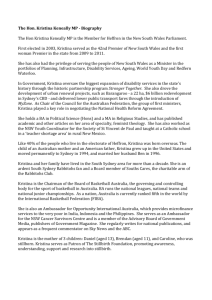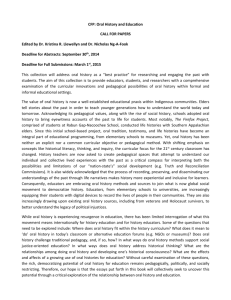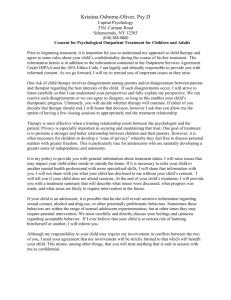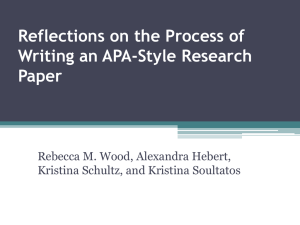1 Kristina of Sweden and Seventeenth Century European Reading
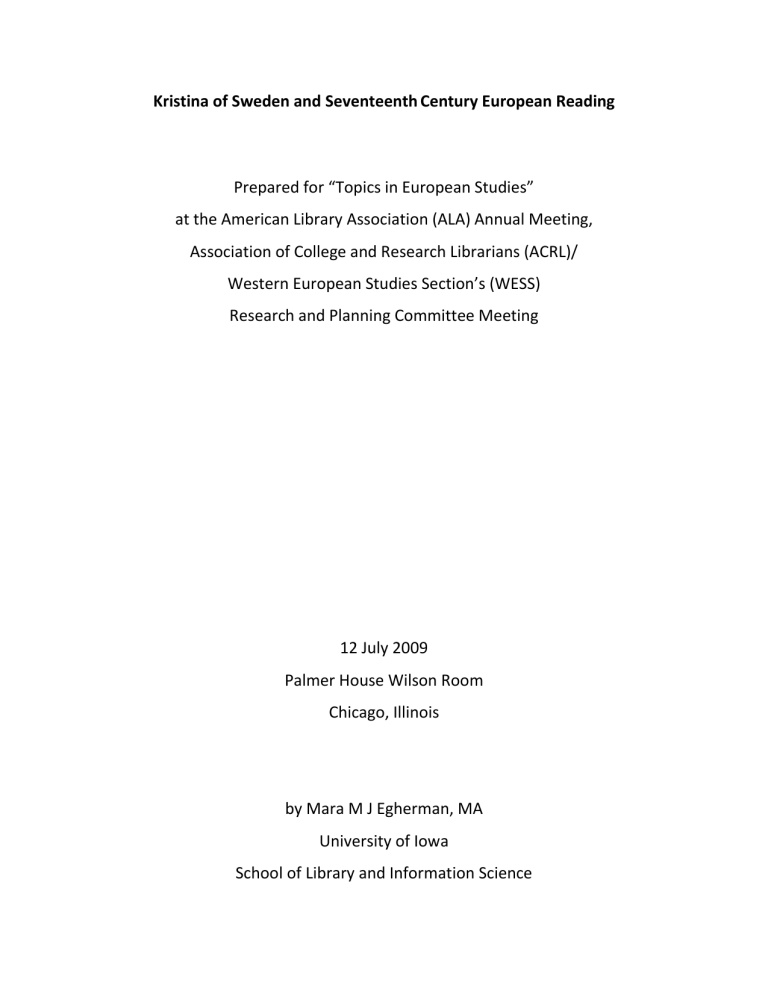
Kristina of Sweden and Seventeenth Century European Reading
Prepared for “Topics in European Studies” at the American Library Association (ALA) Annual Meeting,
Association of College and Research Librarians (ACRL)/
Western European Studies Section’s (WESS)
Research and Planning Committee Meeting
12 July 2009
Palmer House Wilson Room
Chicago, Illinois by Mara M J Egherman, MA
University of Iowa
School of Library and Information Science
Introduction
[SLIDE 1] Thank you all for coming this afternoon. I greatly appreciate feedback
1 on my research-in-progress, either via our questions afterwards or later via email.
Who has heard of Kristina of Sweden? What do you know about her? Several elements of Kristina of Sweden’s significance for the history of reading are summed up in a review of intellectual historian Susanna Åkerman’s 1991 study of
Kristina and her circle (Akerman) by scholar of philosophy Christia Mercer who writes that Kristina [SLIDE 2] was one of the most important, controversial, and enigmatic figures in the seventeenth century. What she did was extraordinary: as a
Protestant, she converted to Catholicism; as a queen, she abdicated her throne and left her country; as a patron, she supported one of the most active intellectual circles in Europe and corresponded with the foremost thinkers of her day. From her contemporaries, she provoked ridicule and admiration, inspired controversy and fear. For the twentieth century scholar, she creates an enormous problem.
The information that we inherit is inconsistent, the views of her contemporaries and subsequent biographers contradictory (289)...
Traditional historians of Scandinavia during the twentieth century typically dismissed Kristina’s reign or Kristina altogether [SLIDE 3] . This was not new
[SLIDE 4] . But other scholars over the centuries have embraced her unique qualities and studied her writings to include a list of maxims and partial
autobiography. Kristina’s book collections and correspondence about books are
2 significant for what Robert Darnton calls in 1982 “the social and cultural history of communication by print” as that field began to be established in the U.S. (9).
Today Kristina is a frequent subject for both scholarship and popular media. In the last decade alone, [SLIDE 5] biographies in English (Buckley), French (Gobry),
Dutch (Lanoye), and Swedish (Englund; Lekeby) have been published, along with a biography for young adults, [SLIDE 6], children [SLIDE 7] , a Swedish movie [SLIDE
8] , and a fictional novel for teens in English. A new historical overview of
Kristina’s time has come out (Lockhart), [SLIDE 9]; a European gender studies scholar included Kristina in her 2007 paper on “Spectacular Queens…[in] Public
History” (Åsberg), and, very useful for my work, a professor at the University of
Chicago has published his study of Kristina’s sometime guardian and political mentor, Swedish chancellor “Axel Oxenstierna (1583-1654) and Books” in
Sixteenth Century Journal (Thomson). Finally, reformation-era historian Susan
Rosa has a book chapter forthcoming on Kristina’s conversion (Rosa).
1
1 Professor Rosa kindly shared her paper with me in preparation of the conference paper I prepared for the Society for Advancement of Scandinavian Studies in May 2009, called “Kristina of Sweden and the History of Reading in
Europe: Crossing Religious and Other Borders.”
My research thus far
I have studied biographies and other writings about the ever-engaging Kristina of
Sweden (1626-1689) in a number of academic environments.
2 My initial work on
Kristina and reading began in a library school seminar on history of reading and readers just over a year ago.
3 There I investigated Kristina primarily as an
3 individual reader and looked for source material indicating which books and manuscripts she owned and which she may have read. I presented a broader follow-up paper a few months later at a European Studies conference approaching Kristina’s intellectual life though the lens of book history or cultural history, and argued how a perspective from those fields may give her a more significant role in Scandinavian and European history than traditional, political science and military-based history has allowed.
4
Preparing the European Studies conference paper led to another research question regarding reading and religious practice, and after delving into
Reformation Studies literature for the first time, in April of 2009 I presented at a
2 Women’s History, Women’s Autobiography & Biography, Scandinavian History, Scandinavian Languages and
Literature, currently Library and Information Science/History of Reading.
3 Taught by Dr. Jennifer Burek Pierce, University of Iowa School of Library and Information Science, spring semester
2008.
4 http://www.unomaha.edu/esc/2008Proceedings/EghermanSweden.pdf
Scandinavian Studies conference, taking a closer look at what Kristina’s role as a
4 reader may have played in her conversion away from the Protestantism that her father Gustavus Adolphus had championed on the battlefields of northern Europe to Roman Catholicism and abdicating the throne, 5 and whether her readingintensive Lutheran upbringing 6 ironically informed her choice to leave that denomination as well as her country.
I also began looking at other seventeenth century European readers with whom
Kristina may have had texts-in-common, or what might have formed Kristina’s
“reading community.” Just as the history of print culture as a field grew outward from the study of books to the study of individual readers and on to groups of readers (Allen; Pawley 142), my research has progressed in a parallel fashion, incorporating several disciplines, now looking at who else would have read the same books Kristina did, how books were passed from one reader to another, and communications between seventeenth century European elite readers and related readers.
5 Sources vary as to whether she converted first, then abdicated, or vice versa. It was illegal to be Catholic in
Sweden at that time, so if she did convert first, she would have done so privately. Lockhart argues that “by 1651 she was definately a practicing Catholic” (72), three years before she abdicated. Olga Opfell notes that it was in
Brussels, in September of 1654 that she took the Catholic oath (105 ), and that public announcement was made of her conversion later at Innsbruck, 1654 (ibid).
6 Book history scholars have found that Protestants, of which Lutherans are a denomination, read significantly more than Catholics in general (Altick 444; Chartier 167).
I have not yet presented this work-in-progress to an audience of librarians and I am pleased to do so today. This paper will speculate on geographical movement of books and manuscripts as well as correspondence about reading throughout seventeenth century Europe, what part Kristina might have played in that and
5 how readers, including Kristina, were connected across national lines. I argue that this international group may be explored as a “reading community” as that concept is known in scholarship on the history of reading. I plan to display the results of this work in a poster to be presented this fall semester as one of my
MLIS degree requirements.
Background
I have not before prepared a poster, so I hoped for an image or vision to come to me in order to graph this out in a visual format. My poster idea had its genesis recently when a few things gelled in my mind. The first was the communication circuit Darnton sketched out to show the “life cycle” of printed books in his 1982 essay “What is the history of books?” (Darnton 10-11). [SLIDE 10] Scholars
studying print culture refer back to this again and again in the literature.
7 In 2005
6 another renowned history of print culture scholar Roger Chartier wrote about early modern Europe and books and readers crossing borders in the journal Book
History. He asserts, “we have to shake the barriers that have separated disciplinary practices and national traditions. Books really do not know such borders” (Chartier 44).
The second thing that helped along the poster vision was that I had been struck by this image [SLIDE 11] 8 as I first began reading the Kristina biographies years ago, because it showed Kristina in academic dialogue with great minds of her day, and as she is situated in her library. Scholars from other countries are represented, the most notable among them is the philosopher René Descartes
(1596-1650), who died at Kristina’s court (Smith). [SLIDE 12] Next to Descartes and also to Kristina’s right are the French ambassador Pierre Chanut, 9 Princess
Elisabeth of Bohemia/Palatine (1618-1680), and the mathematician Marin
7 The spring 2008 SHARP newsletter, for example, has a review of a new book by Miha Kovac that addresses its topic “through the prism of Darnton’s communications circuit” (13).
8 This painting is credited to Pierre-Louis the Younger Dumesnil or Louis-Michel Dumensil (depending on source) created a few years after Kristina’s death.
9 Louis XIV’s representative at the Swedish court (Katz 61).
7
Mersenne (1588-1648) (Buckley).
10 I started thinking about the influence of other
Europeans on Kristina’s reading as well as her, or her books’, influence on them.
Recent Kristina biographer Veronica Buckley states in her caption to this image that “the scene is a fiction,” [SLIDE 13] and while it may be true that not all these people were ever in a room at the same time, the idea that they would have read a similar canon of literature, discussed it via correspondence or visits, and perhaps have given or loaned books to each other would have created a group that may be studied as a reading community.
11
Kristina learned up to twelve languages according to various sources, to include
French, Greek, Italian and Hebrew (Clarke 232; Katz 62). It was written of her by a member of her court that she “reads all Treaties and State Papers, and explains them in Latin to those who don’t understand them” (qtd in Goldsmith 77-78).
I started to make a list of the contacts Kristina had that likely had to do with reading or scholarship in various countries, when I came across the third item in
10 Buckley’s caption to the painting between pages 178-179.
11 I have not as yet studied the scholarship about this painting, but that and other images of Kristina and books could easily form its own scholarly endeavor.
8 the triangle of ideas about this poster: an investigation by now chair of the history of books at Tel Aviv University David Katz into the Dutch scholar, author, book trader and printer Menassah ben Israel’s correspondence with Kristina. By 1640, ben Israel, who hailed from Amsterdam, had “won fame in Europe as the chief interpreter of Jewish theological views to Christian intellectuals” (Katz 58), receiving by 1648 several letters each week from a huge number of correspondents from all over the continent and one in America. That is when it dawned on me how large this network might be.
So after listing Kristina’s contacts and their respective homelands [SLIDE 14], I then made a list of Menassah ben Israels’s contacts [SLIDE 15], linking them with arrows when I found evidence of an overlap, then began visualizing a kind of flow chart in my head.
Starting with the communications circuit, I will fill in some of the “blanks” listing
Kristina’s librarians, other correspondents about reading and where they were from, book and manuscript collections she acquired via one means or another in various cities, perhaps books she left behind, gave away, or used as payment and
in which cities, 12 and superimpose this data on a map of Europe with lots of arrows depicting how correspondence about reading and shipments of texts moved to, from and through Kristina’s domain. This is how it looks so far [SLIDE
16].
9
I hope to access some of Kristina’s letters, which I believe are available through
Kungliga Biblioteket, The Swedish Royal Library, 13 to show an example or two of this exchange of ideas on the poster. I would like to illustrate themes-in-common throughout the circle/cycle of Kristina’s peers. I expect to find that the humanism as articulated by Erasmus of Rotterdam a century before (1466-1536) links most of these readers as this has been demonstrated by other scholars (Åkerman).
I began looking at other figures in the library painting, as a start to plotting it all out. Elisabeth of Bohemia [SLIDE 17], it turns out, also did not want to marry, like
Kristina, and preferred an academic life. Elisabeth read Descartes and corresponded with him about his work. Elisabeth’s brother converted, like
Kristina, from Protestantism to Catholicism. Elisabeth petitioned Kristina for
12 According to Kungliga Biblioteket (The Swedish Royal Library) Kristina, at times paid her librarians in books
<http://www.kb.se/codex-gigas/eng/Long/handskriftens/war-booty/>.
13 Kristina’s correspondence with Descartes appears to be particularly well documented.
support to help her regain her late father’s Palatinate lands. But Kristina invited
10
Descartes to her palace instead. Descartes allegedly accepted Kristina’s invitation partly to try and help Elisabeth (Elisabeth of Bohemia).
Recent Related Scholarship
My work fits with current scholarship in the field. Last month The Society for the
History of Authorship, Readership and Publishing or SHARP hosted a conference in Tampere, Finland, the theme of which was “Books as Material objects, Books in
Space, Books in Movement” (Mäkinen).
14 Another international group of print culture scholars called HIBOLIRE, the Nordic-Baltic Research Network on the
History of Books, Libraries and Reading, sponsored a conference 15 last month.
Lotte Helliga, one of the keynote speakers, according to a reviewer of the conference, “stressed...the importance of lifting one’s eyes from details and over the national boundaries in order to see and tell about the larger context”
(Mäkinen).
16 That sentiment echoed Darnton’s notion that books that “do not respect limits, either linguistic or national” (22). Though a good deal of
14 SHARP, an international group of scholars, is currently geared toward Scandinavia. Their 2008 bi-annual conference in Copenhagen examined questions relating to the “transnational or international qualities of both books and readers” (Halsey 25). SHARP’s next annual meeting will be in Helsinki in 2010. Anticipating this, they have just created a blog to discuss Scandinavian print and manuscript culture at http://bookhistoryupnorth.blogspot.com/ .
15 “Doctoral Summer School” June 4-5, 2009.
16 According to Ma”kinen, Hellinga’s address was titled, “Histories of the Book, Old and New, and What they Have in Common.”
scholarship now is on “common” readers rather than elites, Lithuanian scholar
11
Alma Braziniune 17 gave a senior researcher paper at the Nordic-Baltic conference entitled, “The Private Library as the Object of Research in Book Science and
Librarianship,” that may inform my research.
Librarians as agents of communication in the circuit
I have not yet determined whether any of the following librarians are pictured in the painting of Kristina in her library, but clearly they represent a geographic representation of continental Europe.
Buckley discussed the Swedish Royal Librarian that served the crown during
Kristina’s childhood (70). She wrote that Johann Freinsheim was an authority on Tacitus who taught her most of her Roman history.
He seems to have taught her well, for in later years, the French ambassador noted that she seemed to have no trouble with Tacitus,
‘even the difficult passages, which I found hard myself…’ [Christina] loved the stories of the ancient world, loved reading of the heroic exploits of Caesar and Alexander, loved the tales of nobility and virtue and the unending quest for glory (ibid).
In 1648 a new librarian was installed at Three Crowns Castle: Isaac Vossius, who was 31 years old and hailed from Holland. He was asked to teach the eager
17 Vilnius University
12
Kristina Greek early each morning, and together with the Latinist Nicolaus
Heinsius, organized Kristina’s quickly growing library (Nylander 2).
Kristina sent Vossius and Heinsius out into Europe to purchase books in the early
1650s (Nylander 3). (I will graph these trips with arrows on my poster.) Heinsius surveyed the Italian book market for Kristina, and while in Italy he became acquainted with Lucas Holstenius, who was Cardinal Barberini’s librarian. Later in
Kristina’s life, Holstenius would be her first librarian in Rome (Nylander 4). ( More arrows will connect Stockholm with Rome and many stops in between!)
Gabriel Naudé (1600-1653) came to Sweden in 1652 to assist Kristina after having been librarian to Barberini and Cardinal Jules Mazarin (Masson 169). Naudé was
“an authority on classical dances who had studied in Paris and Padua” (ibid), and he was assisted by Raphael Trichet Du Fresne who was commissioned to catalog
Kristina’s art collection. He has been noted as “no doubt, the most outstanding authority in the library world of his time” (Callmer 59). Emma Jay, author of a
2006 article in Book History on Queen Caroline’s library, puts forth that Naudé’s
1627
“influential treatise on how to stock a library...made... points about the need to cover and classify all branches of knowledge and to compare the works of scholars who were ideologically opposed to one another. Naudé argued that Catholic, Protestant, Jewish,
Muslim, and freethinking writers should all be included, because a universal library should represent confessional differences rather than ignoring them” (Jay 34).
Thomson wondered in his piece on Oxenstierna, whether Naudé’s vision of a
13 library preceded him to Kristina’s court, that “a library ought to contain ‘all the best ancient and modern authors, in the best editions…[and be] accompanied by their most learned and best interpreters and commentators from each faculty’”
(709).
Pierre Chanut was not a librarian but “was one of Christina’s first friends of her own choosing...he recommended new books to her...” (Goldsmith 87). (Here will be another arrow from Paris to Stockholm.) They discussed Descartes’ writings that Chanut gave her (Masson 111). When he died, his memoirs were published and Kristina wrote notes in the margins.
After abdication Kristina travelled south (this is the legendary ride where she was disguised “as a knight with sword and gun...calling herself Count Dohna”), [ SLIDE
18] stopping in Hamburg, Brussels, Innsbruck where she publicly announced her
14 conversion to Catholicism, and on to Rome where she was grandly welcomed
(Opfell 105-107). [SLIDE 19] She had to sell some books along the way. Though
Kristina sometimes paid her librarians and others in books when she was short on funds and gave away books when she had plenty, she nonetheless retained large collections, considering she moved them great distances.
Kristina’s librarian Isaac Vossius cataloged Kristina’s books into twenty-one categories and assembled them into two handwritten volumes, 18 by 1651. The pope bought her library at her death (Cartland 253) and the catalogs are now housed in the Swedish Royal Library (Nylander 3).
How many books?
When she left Sweden, the books Kristina took along amounted to about 5200 in print plus 650 manuscripts, according to the Antwerp Catalog compiled by Vossius
(Katz 65). For comparison, Oxenstierna’s book collection is assumed to have been among the largest in Sweden in the 17 th Century, “easily containing a few thousand books” (Thomson 708). Most of his books were “neither exotic nor
18 Bibliothecae Christinianae Catalogus
expensive. They were printed and were usually in Latin, though the occasional
15
Greek book as well as German, French, Swedish, and (extremely rarely) Italian books also appeared” (ibid 711).
In order to put Kristina’s book and manuscript collections in the context of her era, I will refer to a 2003 article in the Journal of the History of Ideas that provides this summary,
...a typical French royal magistrate in the late fifteenth century would have owned sixty books; one hundred years later Montaigne remarked that he owned about a thousand books, in what would have been an exceptionally large private library for the time; in the early eighteenth century another famous French provincial magistrate, Montesquieu, owned over three thousand books (Blair
15).
Conclusion
I plan to further investigate the history of intellectual thought in seventeenth century Europe to include Scandinavia and the Baltic region, by way of tracing records of who read which books, who owned which books, and who passed which books on. I will keep adding to my chart with names and arrows and affiliations and then see whether there are significant patterns that further link
Kristina and Scandinavia to reading on the European continent in my analysis of this fascinating woman and her reading community.
16
Thanks for coming. I welcome any comments or questions now or emails later.
[ SLIDE 20]
Works Cited
Allen, James Smith. "From the History of the Book to the History of Reading: review essay."
Libraries & Culture (1993): 319-326.
Altick, Richard. "The English Common Reader from Caxton to the Eighteenth Century."
Finkelstein, David and Alistair McCleery, eds. The Book History Reader. New York: Routledge,
2006. 440-449.
Appel, Charlotte. "Literacy in Seventeenth Century Denmark." Hermann, Pernille, ed. Literacy in
Medieval and Early Modern Scandinavian Culture (The Viking Collection: Studies in Northern civilization, vol 16). University Press of Southern Denmark, 2005. 323-345.
Battles, Matthew. Library: an unquiet history. New York: Norton, 2003.
Blair, Ann. "Reading Strategies for Coping with Information Overload ca. 1550-1700." Journal of the History of Ideas 64 (2003): 11-28.
Buckley, Veronica. Christina, Queen of Sweden. London: Fourth Estate, 2004.
—. Christina, Queen of Sweden: the restless life of a European eccentric. London: Fourth Estate,
2004.
Callmer, Christian. "Queen Christina's Library of Printed Books in Rome." von Platen, Magnus.
Queen Christina of Sweden: Documents and Studies. Stockholm: Norstedt & Söner, 1966. 59-
73.
Cartland, Barbara. The Outrageous Queen: a biography of Christina of Sweden. London:
Frederick Muller Ltd, 1956.
Chartier, Roger. "Crossing Borders in Early Modern Europe: sociology of texts and literature."
Book History 8 (2005): 37-50.
17
Chartier, Roger. "The Practical Impact of Writing." Finkelstein, David and Alistair McCleery, eds.
The Book History Reader. New York: Routledge, 2006. 157-181.
Clarke, M.L. "The Making of a Queen: the education of Christina of Sweden." History Today
(1978): 228-235.
Darnton, Robert. "What is the history of books?" The Book History Reader. Ed. David and
Alistair McCleery Finkelstein. 2nd. New York: Routledge, 2006. 9-26.
"Elisabeth of Bohemia." Oregon State University, Philosophy 302. 5 July 2009
<http://oregonstate.edu/instruct/phl302/philosophers/Elisabeth.html>.
Englund, Peter. Silvermasken: en kort biografi över Drottning Kristina. Stockholm: A. Bonnier,
2006.
Garstein, Oskar. Rome and the Counter-Reformation in Scandinavia: the age of Gustavus
Adolphus and Queen Christina of Sweden 1622-1656. Leiden: E.J. Brill, 1992.
Gobry, Ivan. La Reine Christine. Paris: Pygmalion, 2001.
Goldsmith, Margaret. Christina of Sweden: a psychological biography. Garden City, NY:
Doubleday, Doran & Company, Inc, 1935.
Hall, David D. Ways of Writing: The Practice of Text-Making in Seventeenth-Century New
England. Philadelphia, PA: University of Pennsylvania Press, 2008.
Halsey, Katie. "Report on 'Published Words, Public Pages: A Nordic Conference of International
Print Culture'." SHARP News Autumn 2008: 25.
HIBOLIRE News. 3 July 2009 <http://www.helsinki.fi/historia/hibolire/hibolire_news.html>.
Hjortsjö, Carl-Herman. Queen Christina of Sweden: a medical/anthropological investigation of her remains in Rome (Acta Universitatis Lundensis Sectio II: Medica, Mathematica, Scientiae
Rerum Naturalium No.9). Lund: C.W.K. Gleerup, 1966.
Jay, Emma. "Queen Caroline's Library and its European Contexts." Book History 9 (2006): 31-55.
Katz, David S. "Menasseh ben Israel's Mission to Queen Christina of Sweden, 1651-1655."
Jewish Social Studies 45 (1983): 57-72.
Lanoye, Diederik. Christina van Zweden: koningin op het schaakbord Europa, 1626-1689.
Leuven: Davidsfonds, 2001.
Lekeby, Kjell. Kung Kristina: drottningen som ville byta kön. Stockholm: Vertigo förlag, 2000.
18
Lerner, Fred. The Story of Libraries: from the invention of writing to the computer age. New
York: Continuum, 1998.
Lockhart, Paul Douglas. Sweden in the Seventeenth Century (European History in Perspective).
New York: St. Martin's Press/Palgrave Macmillan, 2004.
Mäkinen, Ilkka. Book History Up North. 2 July 2009. 3 July 2009
<http://bookhistoryupnorth.blogspot.com/>.
Masson, Georgina. Queen Christina. New York: Farrar, 1968.
Mercer, Christia. "Review of Susanna Åkerman. Queen Christina of Sweden and Her Circle: The transformation of a seventeenth-century philosophical libertine." Journal of the History of
Philosophy 31 (1993): 289-291.
Meyer, Carolyn. Kristina: the girl king (The Royal Diary series). New York: Scholastic, 2003.
Nylander, Eva Nilsson. "Historien om drottningens bibliotek [History of the Queen's Library]."
Populär historia [Popular History] (1991): 68-72.
Opfell, Olga. Queens, Empresses, Grand Duchesses and Regents: women rulers of Europe A.D.
1328-1989. Jefferson, North Carolina: McFarland & Co, Inc, 1989.
Pawley, Christine. "Seeking 'Significance:' actual readers, specific reading communities." Book
History (2002): 143-160.
Peterson, Gary Dean. Warrior kings of Sweden: the rise of an empire in the sixteenth and seventeenth centuries. n.d.
Rosa, Susan. "Conversion of Queen Christina (1654) and the Rhetoric of Catholic Universalism."
Les modes de la conversion confessionnelle à l’âge moderne: autobiographie, alterité et construction de la conscience religieuse. University of Geneva, forthcoming. 1-25 in draft.
Smith, Kurt. "Descartes' Life and Works." Fall 2008. The Stanford Encyclopedia of Philosophy.
Ed. Edward N. Zalta. 3 July 2009
<http://plato.stanford.edu/archives/fall2008/entries/descartes-works/>.
Thomson, Erik. "Axel Oxenstierna and Books." Sixteenth Century Journal 38.3 (2007): 705-729.
Whitford, David M. "Martin Luther (1483-1546)." Internet Encyclopedia of Philosophy. 6 May
2008 <http://www.utm.edu/research/iep/l/luther.htm>.
Åkerman, Susanna. Queen Christina of Sweden and Her Circle: The Transformation of a
Seventeenth-Century Philosophical Libertine. Ed. A.J. Vanderjagt. Vol. 21 Brill's Studies in
Intellectual History. Leiden: E.J. Brill, 1991.
Åsberg, Cecilia. "Spectacular Queens and the Morals of Excessive Femininity: a feminist approach to public history." Conference Proceedings, INTER: A European Cultural Studies
Conference in Sweden. Norrkoping: Linkoping University Electronic Press, 2007. 687-705.
19

